Jan 20, 2008 | coin design, medals, Morgan, US Mint
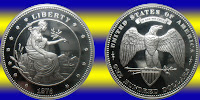 I came across a thread on the Collectors Society message boards about a slabbed medal whose design was based on a sketch by US Mint engraver and artist George T. Morgan. The sketch was found by researchers in 2002 at the Smithsonian Institute. It was buried in the pages of a sketchbook Morgan used to draw design ideas. This sketch was an 1876 idea for the grandest of all coins, a coin with such a high denomination that the design had to be the most beautiful ever proposed. It was the design for a $100 Union gold coin.
I came across a thread on the Collectors Society message boards about a slabbed medal whose design was based on a sketch by US Mint engraver and artist George T. Morgan. The sketch was found by researchers in 2002 at the Smithsonian Institute. It was buried in the pages of a sketchbook Morgan used to draw design ideas. This sketch was an 1876 idea for the grandest of all coins, a coin with such a high denomination that the design had to be the most beautiful ever proposed. It was the design for a $100 Union gold coin.
There appears to be very little written about the coin or why Morgan sketched the design. In 2005, the Smithsonian entered into a deal with the New York Mint to strike private issue gold and silver proof medals based on the design. The New York Mint struck 999 one-ounce gold proof medals, had them certified by NGC, and housed them in a cherry-wood box whose cover has a replica the original Morgan sketch. These medals are sold out. The New York Mint continues to sell a 1½-ounce silver proof coin also certified by NGC issued in a velvet pouch.
Morgan’s design features Miss Liberty, sitting on what appears to be bales of cotton, next to stalks of wheat, on the banks of a river with the mountains in the background. She is holding an olive branch in her left hand and a caduceus on a long staff in her right. Although we think of the caduceus as a medical symbol, it has a history dating back to ancient Greece as an astrological symbol of commerce and attributed to Hermes. It was a symbol to show the Greek authority over trading (the long staff) with the strength to enforce its authority (the wings), with the wisdom to not abuse its power (the snakes). The symbolism is interesting given the history of its use.
Snakes, or serpents, have a long history of being symbols for deceit or other negative symbols. But in ancient Greece, the serpents were a symbol of wisdom and even strength that would inspire the thinkers of the time. Since wisdom can have differing views, two snakes were used to symbolize the balance achieved by considering opposing forces. Interestingly, the Rod of Asclepius was the symbol of healing used by Asclepius, the son of Apollo, and uses one snake to symbolize rebirth—as the snake sheds and re-grows its skin—and fertility.
In later years, the Pagans were known to be fascinated by the mysticism of snakes. Pagan leaders liked to control the masses and adopted the snakes as a sinister representation of wisdom. The practice lead to snakes becoming a representation of the mystics whose faux wisdom was used to empower the animal’s handlers. The handlers would train the snakes to attack on command, which were used as threats to those who would not believe. When the crusades were fought against the Pagans, snake handlers would use their skills to attack Christian soldiers. As the Pagans were defeated and converted to Catholicism, papal edicts banned the use of snakes in all religious ceremonies and symbols. Even though the church had compromised with Pagans and many others to facilitate conversion, the church was adamant about not allowing snakes as part of any religious ceremonies.
When Morgan arrived in the United States from his native Great Britain in 1876, the dominant design on US coinage was seen on the Seated Liberty coins and the Trade Dollar. The Seated Liberty design appears to be based on Britannia with American symbols. Britannia is an allegorical symbol of Great Britain who holds a trident proclaiming her superiority of the sea and a shield emblazoned with the Union Jack saying she is ready to defend her homeland. Britannia is usually depicted wearing a helmet and near the sea. For the Seated Liberty design, the allegorical symbol for Liberty replaces Britannia, a version of the US flag is shaped as a shield showing defense of the new nation, and the trident replaced by the phrygian cap (sometimes called the Liberty Cap) on a pole that is considered a protest symbol as being pro liberty.
It can be speculated that a grand coin, such as a $100 issue, would require a design worthy of the country’s first one hundred years and the growth being seen in recent memory. Morgan may have looked at the phrygian cap and thought that the protest should be over, especially since the United States and Great Britain had normalized relations. Morgan may have thought that the caduceus would represent the new strength of the nation: commerce, after the Transcontinental Express traveled from New York to San Francisco in just over 83 hours. Morgan borrowed the bales of hay and stalks of wheat from the Trade Dollar and placed Miss Liberty on the banks of a river to represent the trading routes offered through the country.
Using the caduceus was an interesting symbolic choice. It has both noble and ignoble meanings throughout history. On one hand, it is a positive symbol of commerce. On the other hand, it is a symbol of deceit in a time when the election of Rutherford B. Hayes as the 19th President and the corruption represented by the political machine of Tammany Hall dominated the headlines. Although the concept for the coin never made it beyond Morgan’s sketch, it can be speculated that the Christians of the time may have objected to its use.
We may never know why George Morgan sketched this pattern or the symbolism he was trying to capture. But given what we know about the symbols, it shows Morgan’s talent for classic design. One can only wonder what our coin designs might have been had his presence was not resented by William and Charles Barber.
Image courtesy of user bsshog40 from the Collectors Society message boards.
Oct 25, 2007 | auction, legal, medals
Newsday was alerted earlier this month that a Pulitzer Prize gold medal won by the newspaper appeared for sale on the eBay auction site. Although that medal turned out to be a replica, reporters found listing for three gold Pulitzer Prize Medals for auction at Heritage Auction Galleries.
Officials from Heritage Auctions listed the 1953, 1970, and 1974 medals that were awarded to Newsday which Heritage deemed as genuine gold award medals. These were the first three of 19 Pulitzer Prizes won by the newspaper. Heritage President Jim Halprin alleges that the medals were consigned from a Long Island coin dealer who claims to have purchased them from an estate sale. The coin dealer has hired an attorney and has not commented.
Newsday executives believed the original medals were stored in a safe in the newspaper’s Melville (Long Island) corporate offices while authorized replicas are on display at in their New York City offices. Executives opened the safe where they thought the medals were stored and found a locked box. When a key could not be located, Newsday hired a locksmith to drill the lock open. The box was empty.
Company officials contacted the FBI to report the theft. The FBI recovered two of the medals that were sold to someone in Florida who is cooperating with the investigation. The other medal will be returned from Heritage Galleries’ offices in Dallas, Texas. All three medals will undergo authentication by the Medallic Art Company, who created the medals for the Pulitzer Foundation.
Halprin defended the auctions claiming that it is Heritage’s policy to verify consignments, especially when they are from someone they have not done business with in the past. He noted that their procedures have been in place since 2001 after previous problems. Halprin did not comment further on this consignment except to say that Heritage will perform an internal investigation into this transaction.
Acquiring an original Pulitzer Gold Medal that was awarded to a newspaper still in existence should be suspicious. One would expect a firm like Heritage would scrutinize the attempt to consign such a prestigious award. Investigating the pedigree of this medal be easy. Since the name of the newspaper is engraved on the medal, the first first act would be to call Newsday to verify the medal’s pedigree. Heritage was probably so ecstatic to obtain such a prize that their eyes probably glazed over and rushed it to auction without doing their due diligence—at least this is how it appears!
Apr 15, 2007 | coin covers, coins, gold, medals, policy, US Mint
I was very surprised to learn that the George Washington First Day Covers were sold out at the US Mint. There have been very few sellouts for the 50 State Quarters™ First Day Covers and others, like the Westward Journey Nickel™ First Day Covers, went off sale after the legal sales date expired. I wonder if this is a “first issue” or it will continue for all presidents? Maybe it will only be for popular presidents where Abraham Lincoln would sell out but not Millard Fillmore?
There has been talk of creating fractional American Buffalo 24-Karat Gold Coins but no indication from the Mint that this will happen. The Mint is offering uncirculated American Silver Eagle coins with the “W” mint mark on a subscription basis. I wonder if the expanded product line is too much for the Mint to handle the additional Buffalo gold coins and whether they are trying to protect the American Eagle gold program?
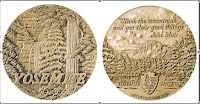 Although I am not a collector of medals, I am amazed at the artwork on the medals produced by the US Mint. While looking at the Mint’s online catalog, I found the new Yosemite Nation Park Centennial Bronze Medal and was just captivated by its design. It seems to capture the grander and beauty of Yosemite. Other medals are just phenomenal in their design. These medals are struck on 90-percent copper and 10-percent zinc blanks in Philadelphia. It may be worth looking into.
Although I am not a collector of medals, I am amazed at the artwork on the medals produced by the US Mint. While looking at the Mint’s online catalog, I found the new Yosemite Nation Park Centennial Bronze Medal and was just captivated by its design. It seems to capture the grander and beauty of Yosemite. Other medals are just phenomenal in their design. These medals are struck on 90-percent copper and 10-percent zinc blanks in Philadelphia. It may be worth looking into.
On December 14, 2006, the Mint announced a ban on the melting and limited the export of cents and nickels for 120 days (4 months). That period was up on Saturday, April 14, 2007 with no further statement from the Mint. Rumor has it that the Mint will issue a statement continuing the melting ban, raise the individual traveler’s limit from $5 to $25 and the numismatic shipments from $100 to $250. It is speculated that this will be a six month extension of the melting ban.
I would like to end with a non-numismatic review. Last night, my wife and I saw the performance of Titus Andronicus by the Shakespeare Theatre Company of Washington, DC. Titus Andronicus is Shakespeare’s most violent plays depicting the revenge strategies and violence of ancient Rome. It is a powerful play about the misplaced sense of honor some have to authority and tradition and how revenge based on that honor can feed upon itself to the detriment of everyone. It is an interesting commentary on today’s society regardless of your political persuasion. Director Gale Edwards did a fantastic job of bringing this play to the stage with great visuals and heart-pumping music. If you live, work, or visit Washington, DC during its run (until May 20), I highly recommend this play.
Image courtesy of the United States Mint.
Mar 29, 2007 | medals, US Mint
Numismatics are used by nations to represent history. They honor important people, significant events, and celebrate the principles that guide a nation to a successful history. Those of us who collect legal tender items have seen this in the coinage and currency that marks United States history. One area of this celebration that goes under reported and under appreciated are medals.
Like everything else the US Mint produces, the Mint produces medals as they are legislated by congress and signed by the President. As part of the Mint’s medal programs, they produce medals copies of the official medal for each president as well as the Secretaries of the Treasury and Directors of the US Mint. Other medals the Mint is requested to produce are copies of the special medals that are awarded by congress to citizens for their extraordinary service to the nation.
Today, March 29, congress will honor the Tuskegee Airmen with the Congressional Gold Medal. Formed in 1942, the Tuskegee Airmen were African-American fighter pilots who the Army Air Corps considered “not intelligent enough” to be fighter pilots. These brave men went onto fight in successful campaigns against the Axis powers in the skies over Europe. They went on to dispel the racist preconceptions of the military that lead to General Dwight Eisenhower to integrate the armed forces.
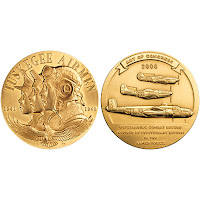 Although it has been more than 60 years since their heroism, it is appropriate that these heroes are honored with the country’s highest award. A ceremony will be held today in the Capital Rotunda to award the Tuskegee Airmen with the specially designed medal. President George W. Bush and former Secretary of State Colin L. Powell, a 1991 medal recipient, will deliver speeches at the event.
Although it has been more than 60 years since their heroism, it is appropriate that these heroes are honored with the country’s highest award. A ceremony will be held today in the Capital Rotunda to award the Tuskegee Airmen with the specially designed medal. President George W. Bush and former Secretary of State Colin L. Powell, a 1991 medal recipient, will deliver speeches at the event.
This award was authorized under Public Law 109-213 (GPO: [text]/[PDF]). It also specifies that a bronze version of the medal be offered for sale to the public. As of noon today, the Mint is offering bronze 3-inch and 1½-inch versions of the medal that will be awarded today. It is a beautiful medal and a wonderful tribute to real heroes.
Image from the US Mint
Mar 12, 2006 | coins, currency, history, medals, silver
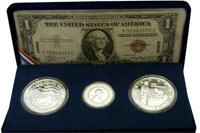 In this time of uncertainty, I feel that we Americans need to remember those who have given their lives in defense of this country. This is not a political statement on the current Middle East situation, but an appreciate of those with their boots on the ground who risk their lives daily. As part of that, my wife and I visited the U.S.S. Arizona (BB-39) Memorial at Pearl Harbor during our trip to Hawaii. Unfortunately, rain prevented us from visiting the U.S.S. Missouri (BB-63) Memorial.
In this time of uncertainty, I feel that we Americans need to remember those who have given their lives in defense of this country. This is not a political statement on the current Middle East situation, but an appreciate of those with their boots on the ground who risk their lives daily. As part of that, my wife and I visited the U.S.S. Arizona (BB-39) Memorial at Pearl Harbor during our trip to Hawaii. Unfortunately, rain prevented us from visiting the U.S.S. Missouri (BB-63) Memorial.
In front of the gift shop that is inside the Visitors Center was a table with gentleman selling Pearl Harbor commemorative medals and sets produced by the Honolulu Mint. I was very intrigued by the items and gravitated to the commemorative set that contains two .999 Silver, 1 Troy Ounce medals, an uncirculated 1943 Steel Lincoln Cent, and a Series 1935A Hawaii issue Silver Certificate. Even though I am not a commemorative collector, I do tend to buy numismatic items from my personal experiences. While standing in the Memorial, and with my wife’s urging, I could not pass up buying this set.
-
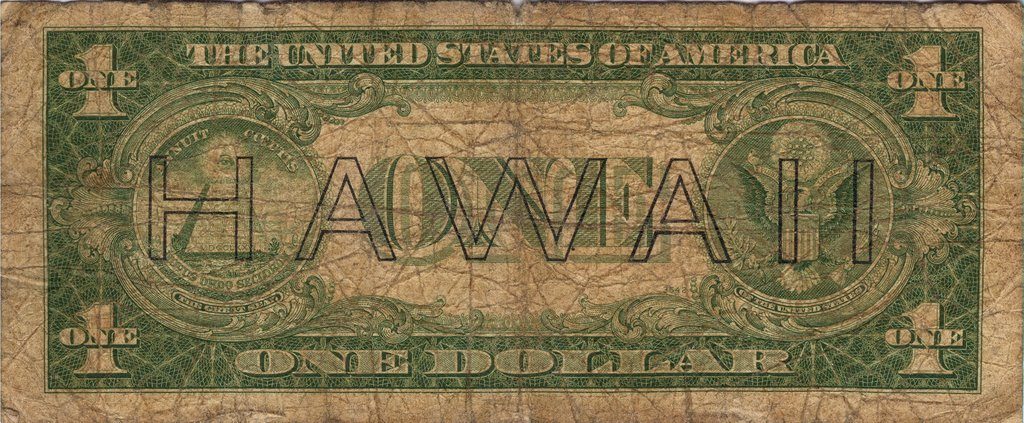
-
Series 1935A Silver Certificate with “HAWAII” Overprint Reverse
The set includes a medal commemorating the 65th Anniversary of the Japanese bombing of Pearl Harbor. The obverse shows the U.S.S. Arizona and the anniversary date. The reverse shows an arial view of the memorial with the outline of the sunken ship in the water. On the image are the words “Honoring all those who made the ultimate sacrifice on Dec. 7, 1941.”
-
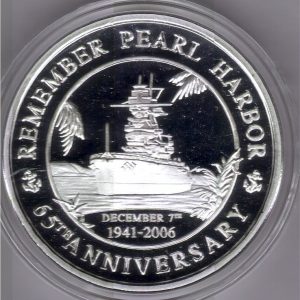
-
Obverse of the Pearl Harbor 65th Anniversary silver medal
-
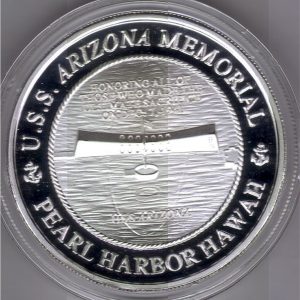
-
Reverse of the Pearl Harbor 65th Anniversary silver medal
The other medal commemorates the Japanese surrender aboard the U.S.S. Missouri. It was prophetic that the articles of surrender were signed on her deck. The obverse of this medal recreates the signing of the document by General Yoshijiro Umezu, Chief of the Army General Staff, with Lieutenant General Richard K. Sutherland standing across the table. The reverse has the inscription on the deck of the Missouri where the articles were signed.
-
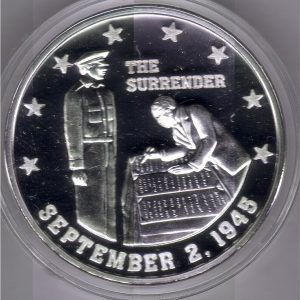
-
Obverse of the Japanese Surrender Silver Medal
-
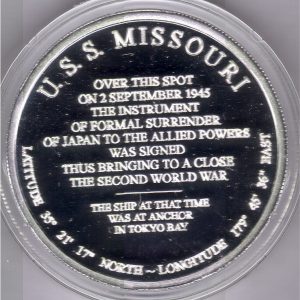
-
Reverse of the Japanese Surrender Silver Medal
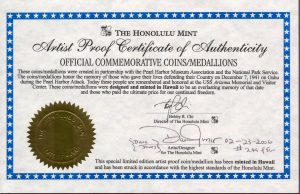
Personally autographed COA from the Honolulu Mint
Although everyone should visit the U.S.S. Arizona Memorial and the rest of Pearl Harbor, I know it is not a trip that every can take. So if you are interested in this collectible and other medals honoring those who served and gave the ultimate sacrifice, you can visit the Honolulu Mint’s website or the U.S.S. Arizona Memorial Bookstore. Portions of the proceeds benefit the Memorial.
 I came across a thread on the Collectors Society message boards about a slabbed medal whose design was based on a sketch by US Mint engraver and artist George T. Morgan. The sketch was found by researchers in 2002 at the Smithsonian Institute. It was buried in the pages of a sketchbook Morgan used to draw design ideas. This sketch was an 1876 idea for the grandest of all coins, a coin with such a high denomination that the design had to be the most beautiful ever proposed. It was the design for a $100 Union gold coin.
I came across a thread on the Collectors Society message boards about a slabbed medal whose design was based on a sketch by US Mint engraver and artist George T. Morgan. The sketch was found by researchers in 2002 at the Smithsonian Institute. It was buried in the pages of a sketchbook Morgan used to draw design ideas. This sketch was an 1876 idea for the grandest of all coins, a coin with such a high denomination that the design had to be the most beautiful ever proposed. It was the design for a $100 Union gold coin.








